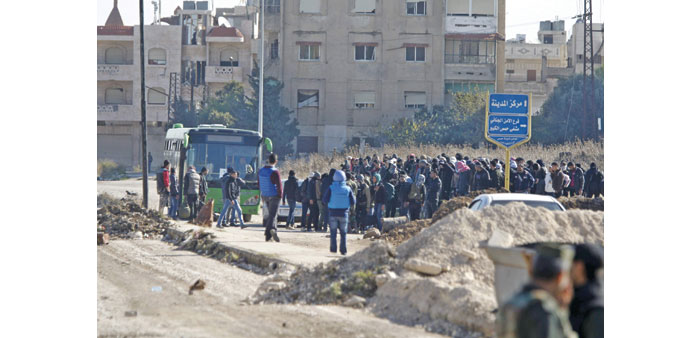Reuters
Homs, Syria/Beirut
Busloads of Syrians including rebel fighters left the last insurgent-held area of Homs yesterday under a rare local truce in Syria’s nearly five-year conflict that will shore up government control over the city.
The rebels and their families are being moved to insurgent-held areas of the northwest near the Turkish border under the deal, an example of the type of local truce US President Barack Obama has said could happen in Syria more frequently.
Homs was a centre of the uprising against President Bashar al-Assad. The deal follows a major Syrian army ground offensive to the north of the city backed by Russian air strikes.
Witnesses saw 15 buses leave the area. Homs governor Talal al-Barazi told reporters 300 fighters were on board, together with 400 members of their families. The fighters took light weapons with them, he said.
The deal echoes a local ceasefire agreed in September elsewhere in Syria under which rebel fighters were supposed to be transferred to Idlib, though it has yet to be fully implemented.
Several buses left the Homs district of Waer early yesterday and others were queuing up to leave on its outskirts, witnesses said. Children on buses waiting to leave peeked around the drawn curtains and aid workers handed out juice.
Barazi said the buses would make a stop in Hama province, where rebels who wished to could disembark, before continuing to Idlib, a province that is a stronghold of insurgents including the Al Qaeda-linked Al Nusra Front.
He described the rebels who left as “militants who reject the agreement”, saying they would leave with their families.
“The Waer neighbourhood arrangements will be completely safe and there will be no weapons in Waer after the implementation of the agreement,” he said, adding security forces would go back to work in the area and would be the only ones armed.
The Britain-based Syrian Observatory for Human Rights monitoring group said about 750 people were expected to leave during the day for rebel-held areas in the Hama and Idlib provinces.
The United Nations is presiding over implementation of the deal, which was agreed directly between the Syrian sides.
Some diplomats say local ceasefires may be the most effective way of gradually bringing peace to a country where more than 250,000 people have been killed, though one concluded in Homs in 2014 was widely seen as a forced surrender.
Syria peace talks involving world powers in Vienna in October called for a nationwide ceasefire and a renewal of UN-brokered talks between the rival Syrian sides.
“Our clear goal is to reach as soon as possible a nationwide ceasefire. Meanwhile, initiatives like this one bring relief to besieged or isolated communities and have great value,” UN mediator Steffan De Mistura’s spokeswoman Jessy Chahine said.
“They help the perception that a nationwide ceasefire brokered by the members of the ISSG (International Syria Support Group) is doable and that the UN can and will do its part,” Chanine added, referring to the Vienna meeting countries.
Priority is being given to women, children and the severely wounded, Observatory head Rami Abdel Rahman said. But the evacuation will include scores of fighters who reject the truce, he said, among them a small group from Al Nusra Front.
A previous truce in Homs in 2014 allowed insurgents to withdraw from the Old City while Waer and other areas remained in the hands of insurgents.
The Observatory said the Waer deal was better for the rebels than the 2014 agreement because some fighters will stay in the district and the deal will be implemented in stages.
Humanitarian aid reached the Waer district last week under the terms of the agreement.

